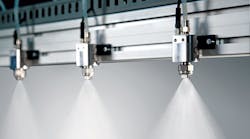Spraying Perfection in a Changing World
Even coating, perfect coverage: Whatever industry you're in, whatever fluid you are applying, these are the objectives of any spraying system.
And these goals are relatively easy to achieve in a vacuum. If your manufacturing system remains steady and your conveyors and processing times maintain a consistent, unwavering tempo, engineers can lock in spray system settings and define the precise pressures, distributions, and spray angles required to achieve optimal results.
The problem, of course, is that today's ever-changing, demand-based manufacturing environment can be far too dynamic to rest on these locked-in settings. This puts all of the performance variables into flux with no clear way to achieve consistent, optimal coverage across such a broad range of processing rates.
To help cope with these demands, Spraying Systems Co. has developed Precision Spray Control—a novel system that automatically adjusts all of these settings and variables to correspond with the real-time changes in conveyor speeds, allowing operators to achieve even coatings and perfect coverage with their spraying systems, no matter what comes down the line.
Recently, we connected with Spraying Systems' Tim Hennessy—the lead design engineer for the PulsaJet nozzle that makes the Precision Spray Control system possible—to find out a little more about how the system works and what benefits it brings to the market.
NED: Okay, let's start with the basics: What is Precision Spray Control and what role did you play in its development?
Hennessy: My responsibilities were with the PulsaJet spray nozzles, which basically is the solenoid valve operated to control flow rates to our spray tips.
We developed our own control systems to drive this unit and, in collaboration with our controls group, we created a PulsaJet to try to get us the best performance.
The system automatically adjusts the flow control on the valve to increase or decrease the flow if your conveyor speeds up or if you want to increase production or whatever the requirement is, just by monitoring the speed of the belt. This way the application rate stays the same no matter what, which allows better quality control for the customer on their product without trying to adjust pressures or other control elements that are usually slower to react.
NED: So you put the precision in the Precision Spray Control?
Hennessy: That's right.
NED: How does this system differ from other spraying systems on the market?
Hennessy: Probably the biggest one is pressure control.
A lot of times if you were to change the flow rate, you would do that by adjusting the pressure up or down depending on whether you want more flow or less flow, but that causes issues with your quality.
If you're using a fan spray, for example, you get certain coverage at a certain pressure. But if you increase the pressure, that spray angle gets wider and the coverage gets wider, or if you drop the pressure, you get less flow and that spray angle gets smaller and you get less coverage.
So, at a certain setting, you may get really good coverage across the board, but if you change the pressure up or down, that coverage may get inconsistent and cause quality problems.
Also, if you change the pressure in the tip, the drop size produced by that tip changes. It could be bigger drops or smaller drops and may not be appropriate for what the customer desires for the product.
With our system, you're able to keep pressure constant and you keep those things associated with those pressures the same. Drop size and coverage remain the same; the only thing that changes is the flow rate.
NED: You take a lot of the variables out of the process.
Hennessy: That's right. Exactly.
NED: Where did the idea for this system come from, exactly?
Hennessy: We had made special products for customers in the printing industry. They use it to moisturize the stock to keep the paper straight.
But we felt over that time that this could be used in many other areas as well. Not the exact same nozzle, but the same idea could be used in metal lubrication and food with products—any situation where you're trying to control the flow rates precisely and you need to make these adjustments quickly.
So we developed a nozzle that uses our standard spray tips and provides a basic amount of flow control.
NED: I like that. You basically took an idea from a custom job and applied it to other industries. Did you have to do any redesign for that process?
Hennessy: Yes we did.
One of the problems that we needed to solve was the valve was kind of clunky to adjust. It had screws that you would adjust to control some of the operational speed, so things would change over time and it was difficult to keep the gun in tune and other things like that. That was maybe the biggest issue.
The new design made the gun more robust and more consistent over time and deliver the proper performance for a high-speed operation that allows the customer flow control.
The way the guns work is, we turn them on and off many times a minute. That can be 10,000, 15,000 times per minute. A lot of times, they'll work 1,000 to 2,000, it just depends on what's needed.
But there are times when the gun is off which means there's no spray coming out. The gun has to be responsive enough so that when the gun is off and the conveyor moves, you don’t miss the next spot on the conveyor. The nozzles need to be responsive enough to spray and avoid stripes on the surface of the product.
So we needed to develop a valve that was very fast-acting to prevent those types of issues.
NED: What do you think this system adds to the market and to manufacturers' functionality or productivity?
Hennessy: For one, we were able to reduce the waste of the product they are spraying.
When spraying hydraulically, you get some mist but you don’t get anywhere near the mist you get when you're spraying with an atomizer. A lot more of that product is going right where you want it to go. It's not going up some exhaust hood or onto the floor where it has to be cleaned up later and could cause some injuries if someone slips on the oil.
So that's one of the biggest things, just reducing waste.
Also, at the end of the day, the product quality that you're making is going to be better. You can control that flow rate better to get the exact coverage you want on your product.











